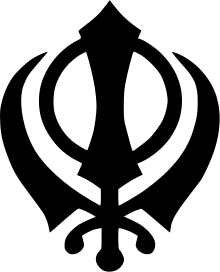Mata Sahib Kaur
| This article is part of a series on |
| Sikhism |
|---|
 |
|
Sikh Saints
|
|
Philosophy
|
|
List
|
|
Sikhism portal Indian religions portal |
Mata Sahib Kaur (Gurmukhi: ਮਾਤਾ ਸਾਹਿਬ ਕੌਰ, Shahmukhi: ماتا صاحب کور) a follower of the tenth Sikh guru Guru Gobind Singh.[1] Born Sahib Devan, she was the daughter of Ramu of Rohtas dist. Jhelum.[2] Mata Sahib Kaur Ji was born in 1681 and was offered to be a bride of Guru Gobind Singh Ji by her father Bhai Rama Ji, a devout Nanak Naam Leva Sikh in 1700 .
Marriage proposal
When the proposal was brought for discussion to Anandpur, the Guru had already been married to Mata Sundari Ji. Therefore, the Guru said that he could not have another wife since he was already married. The dilemma before the parents of the girl was that, the proposal having become public, no Sikh would be willing to marry a woman who had been betrothed to the Guru. The Guru agreed for her to stay at Anandpur but without accepting her as his wife on two terms, 1) That his relationship with Mata Sahib Deva would be of a spiritual nature and not physical and 2) Mata Sahib Deva would have to take Amrit.
The question arose, as most women desire to have children, how could she have one without being married. The Guru told that, "She will be the 'mother' of a great son who will live forever and be known all over the world."
Khalsa was created in 1699 and the sweetness in Amrit was the result of some patashes (sugar wafers) added by Mata Sahib Kaur. She meant that Khalsa should be polite and humble also not only arrogant in nature. Thus by initiating Amrit, a Khalsa becomes SAINT SOLDIER. Later on she was given title of MOTHER OF KHALSA by Guru ji saying that from now on today, you will be mother of khalsa. (ajj to Kahlsa tuhadi jholi paaia, tusin ajj to Khalsa di mata ho).
During the battle of Anandpur Sahib Mata Sahib Kaur Ji was split from the holy family of the tenth Guru during the siege of Fort Keshgarh where along with Mata Sundari Ji they were escorted to safety to Sri Damdama Sahib by Bhai Sahib Bhai Mani Singh Ji Shaheed.
Mata Sahib Kaur Ji accompanied Guru Gobind Singh Ji to Delhi and then on to Nanded whilst Mata Sundari Ji stayed back in Delhi.
It was in Nanded that Guru Gobind Singh Ji informed Mata Ji of his time to leave Earth for his heavenly abode at which he commanded Mata Ji to leave for Delhi to be with Mata Sundari Ji, Guru Ji gave Mata Sahib Kaur Ji 5 weapons as his reminder and his Insignia (with which Mata Ji issued 9 Hukkamnaama's or Letters of Command for the Khalsa). Mata Sahib Kaur Ji resided in Delhi with Mata Sundari Ji and lived a life of Simran and Seva (selfless service) for the panth (nation).
In 1747 at the age of 66 Mata Sahib Kaur Ji renounced her body and left for her heavenly abode. The place of Mata Ji's cremation is Gurdwara Bala Sahib Ji, the same place where Sri Guru Har Krishan Sahib Ji was cremated.
Presence during Amrit Sanchaar
There are different views among Sikh historians on her presence during this event. As per Mahankosh, Bhai Kahn Singh Nabha Mata Sahib Devan was present during creation of Khalsa Panth[3] but Twarikh Guru Khalsa refute this claim.[4] According to Mahankosh, Mata Sahib Kaur Ji participated in making Pahul by adding sugar wafers to it but Twarikh claims, Mata Jito (First wife) put sugar wafters to the Pahul and Sahib Devan was not married to Guru Gobind Singh at that time.
See also
References
- ↑ Dalbir Singh Dhillon (1988). Sikhism Origin and Development. Atlantic Publishers & Distributors. Retrieved 2011-07-30.
- ↑ Surinder Singh Johar (1999). Guru Gobind Singh: a multi-faceted personality. M.D. Publications. p. 139. ISBN 978-81-7533-093-1.
- ↑ ਰੋਹਤਾਸ ਨਿਵਾਸੀ ਭਾਈ ਰਾਮੂ ਬਸੀ¹ ਖਤ੍ਰੀ ਦੀ ਸੁਪੁਤ੍ਰੀ, ਜਿਸ ਦਾ ਆਨੰਦ ੧੮. ਵੈਸਾਖ ਸੰਮਤ ੧੭੫੭ ਨੂੰ ਸ਼੍ਰੀ ਗੁਰੂ ਗੋਬਿੰਦ ਸਿੰਘ ਜੀ ਨਾਲ ਹੋਇਆ. ਕਲਗੀਧਰ ਨੇ ਇਸੇ ਦੀ ਗੋਦੀ ਪੰਥ ਖਾਲਸਾ ਪਾਇਆ ਹੈ, ਇਸੇ ਕਾਰਣ ਅਮ੍ਰਿਤਸੰਸਕਾਰ ਸਮੇਂ ਮਾਤਾ ਸਾਹਿਬ ਕੌਰ ਅਤੇ ਪਿਤਾ ਸ਼੍ਰੀ ਗੁਰੂ ਗੋਬਿੰਦ ਸਿੰਘ ਜੀ ਉਪਦੇਸ਼ ਕੀਤੇ ਜਾਂਦੇ ਹਨ. ਅਵਿਚਲ ਨਗਰ ਪਹੁੰਚਕੇ ਦਸ਼ਮੇਸ਼ ਨੇ ਇਨ੍ਹਾਂ ਨੂੰ ਦਿੱਲੀ ਭੇਜ ਦਿੱਤਾ ਅਰ ਗੁਰੂ ਹਰਿਗੋਬਿੰਦ ਸਾਹਿਬ ਦੇ ਪੰਜ ਸ਼ਸਤ੍ਰ ਸਨਮਾਨ ਨਾਲ ਰੱਖਣ ਲਈ ਸਪੁਰਦ ਕੀਤੇ, ਜੋ ਹੁਣ ਦਿੱਲੀ ਗੁਰੁਦ੍ਵਾਰੇ ਰਕਾਬਗੰਜ ਵਿੱਚ ਹਨ.#ਮਾਤਾ ਜੀ ਦਾ ਦੇਹਾਂਤ ਮਾਤਾ ਸੁੰਦਰੀ ਜੀ ਤੋਂ ਪਹਿਲਾਂ ਹੋਇਆ ਹੈ. ਸਮਾਧੀ ਗੁਰੂ ਹਰਿਕ੍ਰਿਸਨ ਜੀ ਦੇ ਦੇਹਰੇ ਪਾਸ ਦਿੱਲੀ ਹੈ. ਦੇਖੋ, ਦਿੱਲੀ., Mahankosh, Bhai Kahn Singh Nabha
- ↑ Twarikh Guru Khalsa, Page 177, Topic: Teesri Shadi
| ||||||||||||||||||||||||||||||||||